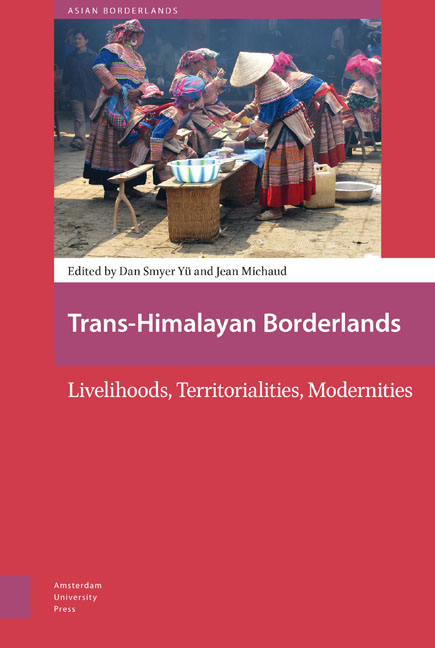Book contents
- Frontmatter
- Contents
- Acknowledgements
- Introduction: Trans-Himalayas as Multistate Margins
- I Territory, Worldviews, and Power Through Time
- 1 Adjusting Livelihood Structure in the Southeast Asian Massif
- 2 The Properties of Territory in Nepal’s State of Transformation
- 3 Trans-Himalayan Buddhist Secularities: Sino-Indian Geopolitics of Territoriality in Indo-Tibetan Interface
- 4 Buddhist Books on Trans-Himalayan Pathways: Materials and Technologies Connecting People and Ecological Environments in a Transnational Landscape
- 5 Seeking China's Back Door: On English Handkerchiefs and Global Local Markets in the Early Nineteenth Century
- II Livelihood Reconstructions, Flows, and Trans-Himalayan Modernities
- 6 Contested Modernities: Place, Subjectivity, and Himalayan Dam Infrastructures
- 7 Plurality and Plasticity of Everyday Humanitarianism in the Karen Conflict
- 8 Being Modern: Livelihood Reconstruction among Land-lost Peasants in Chenggong (Kunming)
- 9 Tibetan Wine Production, Taste of Place, and Regional Niche Identities in Shangri-La, China
- 10 Tea and Merit: Landscape Making in the Ritual Lives of the De’ang People in Western Yunnan
- 11 In-between Poppy and Rubber Fields: Experimenting a Transborder Livelihood among the Akha in the Northwestern Frontier of Laos
- 12 A Fortuitous Frontier Opportunity: Cardamom Livelihoods in the Sino-Vietnamese Borderlands
- Conclusion: Frictions in Trans-Himalayan Studies
- Index
1 - Adjusting Livelihood Structure in the Southeast Asian Massif
Published online by Cambridge University Press: 12 December 2020
- Frontmatter
- Contents
- Acknowledgements
- Introduction: Trans-Himalayas as Multistate Margins
- I Territory, Worldviews, and Power Through Time
- 1 Adjusting Livelihood Structure in the Southeast Asian Massif
- 2 The Properties of Territory in Nepal’s State of Transformation
- 3 Trans-Himalayan Buddhist Secularities: Sino-Indian Geopolitics of Territoriality in Indo-Tibetan Interface
- 4 Buddhist Books on Trans-Himalayan Pathways: Materials and Technologies Connecting People and Ecological Environments in a Transnational Landscape
- 5 Seeking China's Back Door: On English Handkerchiefs and Global Local Markets in the Early Nineteenth Century
- II Livelihood Reconstructions, Flows, and Trans-Himalayan Modernities
- 6 Contested Modernities: Place, Subjectivity, and Himalayan Dam Infrastructures
- 7 Plurality and Plasticity of Everyday Humanitarianism in the Karen Conflict
- 8 Being Modern: Livelihood Reconstruction among Land-lost Peasants in Chenggong (Kunming)
- 9 Tibetan Wine Production, Taste of Place, and Regional Niche Identities in Shangri-La, China
- 10 Tea and Merit: Landscape Making in the Ritual Lives of the De’ang People in Western Yunnan
- 11 In-between Poppy and Rubber Fields: Experimenting a Transborder Livelihood among the Akha in the Northwestern Frontier of Laos
- 12 A Fortuitous Frontier Opportunity: Cardamom Livelihoods in the Sino-Vietnamese Borderlands
- Conclusion: Frictions in Trans-Himalayan Studies
- Index
Summary
Abstract
The uplands east of the Himalayan range stretch over 10 countries, deep into Northeast India, Southwest China, and Mainland Southeast Asia. This region, which I call the Southeast Asian Massif, harbors high valleys and mountain ranges where a staggering diversity of cultures and social systems have thrived or, according James C. Scott's thesis, found a refuge against state inclusion. This chapter offers a general introduction to these populations, focusing on geography, social structures, livelihood practices, relationships with the state and the lowlands, and current issues revolving around rampant modernization and forced inclusion to the global economic order.
Keywords: Southeast Asian Massif, Zomia, minorities, livelihoods, modernization
I have suggested elsewhere that what the peoples living in the Highlands of Asia, and in particular in the Southeast Asian Massif, possibly share most is a sense of being different from the majorities surrounding them, a sense of geographical remoteness, and a state of marginality and sometimes domination, all of which connected to a degree of cultural, political, and economic remoteness from Asia's main seats of power in the lowlands, the river deltas and the coastal zones (Michaud 2006). Geographical remoteness becomes a sign of political separation and subordination for those peoples who through history are most likely to have been classified by the powersthat- be as inferior, dangerous, ‘uncivilized,’ ‘savage,’ ‘barbarian,’ or ‘raw.’ And to add to this complexity, their visual representation on an ethnolinguistic map yields a highly fragmented cultural mosaic with contrasting colors rather than a legible picture in harmonized shades.
Yet, from a distance, when ‘jumping scale’ as Van Schendel (2002) put it, this highland mosaic can form a distinctive and relatable picture, becoming a legitimate subject for academic research, though clearly an unusual one. In this chapter, I first paint a portrait of the highlands at the time of contact with European observers, in order then to better see the current trends in livelihoods adjustments influenced by the political and economic relationship tying together the highlanders with the modern state and the global market.
All twelve chapters in this book belong to Van Schendel's greater Zomia. But seven of these belong more precisely to James C. Scott's smaller Zomia (Cederlöf, Turner, Li Yunxia, Horstmann, Galipeau, Yang, and Li Quanmin); therefore they also fit into the Southeast Asian Massif.
- Type
- Chapter
- Information
- Trans-Himalayan BorderlandsLivelihoods, Territorialities, Modernities, pp. 45 - 64Publisher: Amsterdam University PressPrint publication year: 2017



